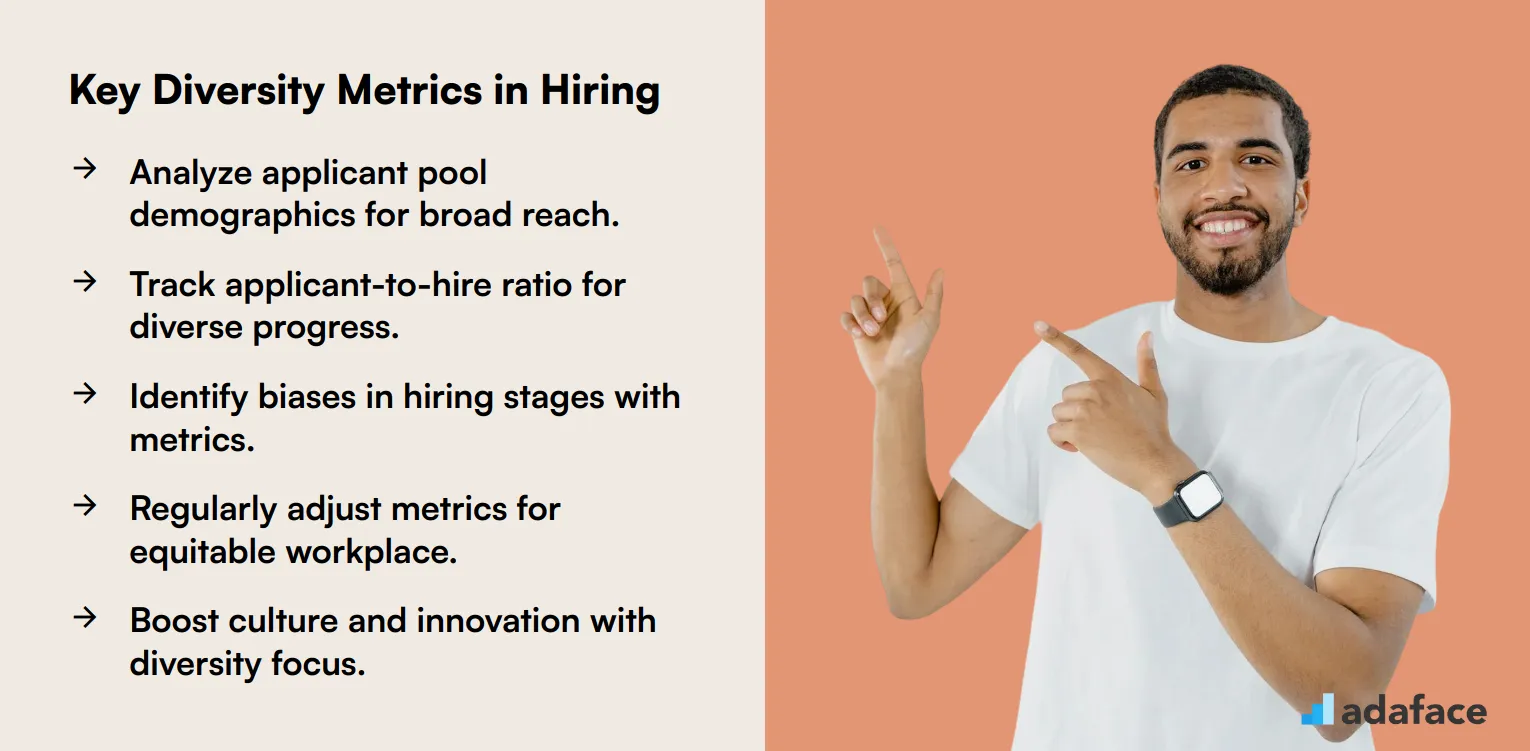In today's competitive job market, understanding DEIB (Diversity, Equity, Inclusion, and Belonging) metrics is crucial for recruiters. These metrics help organizations create a more inclusive and equitable hiring process, which can lead to a more diverse workforce.
Recruiters can improve their hiring strategies by focusing on key DEIB metrics. By measuring diversity, equity, inclusion, and belonging, HR professionals can identify areas for improvement and implement strategies to foster a more inclusive workplace.
Table of contents
Understanding DEIB Metrics in Recruitment
Understanding DEIB metrics in recruitment is key for creating a more inclusive workplace. These metrics help recruiters and hiring managers assess how well their recruitment processes are supporting diversity, equity, inclusion, and belonging.
DEIB metrics can include data on the diversity of applicant pools, the inclusivity of job descriptions, and the equity of interview processes. By analyzing these metrics, organizations can identify areas where they excel and where they need improvement.
For example, measuring the diversity of your candidate funnel can reveal whether your outreach efforts are attracting a varied group of candidates. Additionally, evaluating the equity of your interview processes can ensure that all candidates have a fair chance, regardless of their background.
Incorporating DEIB metrics into recruitment not only fosters a more diverse workforce but also enhances the overall candidate experience. It allows companies to make data-driven decisions to improve recruitment strategies and create a more welcoming environment for all potential employees.
Ultimately, understanding and utilizing DEIB metrics can lead to more successful hiring outcomes and a more cohesive and productive workplace. By prioritizing these metrics, organizations can better align their recruitment practices with their DEIB goals.
Key DEIB Metrics for HR Professionals
For HR professionals, understanding key DEIB (Diversity, Equity, Inclusion, and Belonging) metrics can significantly enhance recruitment strategies. These metrics provide insights into how diverse and inclusive a workplace truly is, helping to identify areas for improvement and celebrate successes.
One important metric is the diversity hiring rate, which measures the percentage of diverse candidates hired compared to all hires. This metric helps organizations evaluate their recruitment processes and ensure they are attracting a diverse talent pool.
The inclusion index is another vital metric, assessing how included employees feel within the workplace. It typically includes survey questions about belonging, voice, and respect, offering a snapshot of the company's inclusive culture.
Equity metrics focus on pay equity and promotion rates among different demographic groups. By analyzing these metrics, HR professionals can pinpoint disparities and work towards a fairer workplace.
Lastly, the belonging score gauges employees' sense of belonging within the company. High belonging scores often correlate with increased employee engagement and retention, making it a key focus for HR teams aiming to improve the candidate experience.
Measuring Diversity in Your Hiring Process
Measuring diversity in your hiring process is a key step towards fostering an inclusive workplace. It involves assessing the representation of different genders, races, and backgrounds in your candidate pool.
To gauge diversity, start by analyzing your applicant pool demographics. This will help you understand if your recruitment efforts reach a broad and varied audience.
Utilize metrics such as the applicant-to-hire ratio to track how diverse candidates progress through the candidate funnel. This can reveal potential biases or barriers within your hiring stages.
Incorporating diversity metrics into your recruitment strategy can enhance your organization's culture and innovation. It ensures that you are not only attracting diverse talent but also providing them with equal opportunities to succeed.
Regularly reviewing and adjusting your diversity metrics can lead to a more equitable and dynamic workplace. This proactive approach supports long-term growth and aligns with modern recruitment strategies.

Equity Indicators in Recruitment
Equity indicators in recruitment are metrics that help identify and address disparities in hiring processes. These indicators ensure that all candidates, regardless of their background, have equal opportunities to succeed. By focusing on equity, organizations can create a more diverse and inclusive workforce, which can lead to better decision-making and innovation.
One critical equity indicator is the gender pay gap, which measures the difference in earnings between male and female employees. Monitoring this gap helps organizations identify areas where pay equity needs improvement. Another important metric is the representation of underrepresented groups in the candidate pool and at various stages of the hiring process.
Tracking the diversity of applicants at each stage can reveal potential biases in the recruitment funnel. This can include evaluating the diversity of candidates who are sourced, interviewed, and ultimately hired. By analyzing these metrics, companies can implement targeted recruitment strategies to ensure a more equitable process.
Equity indicators also involve assessing the inclusivity of job descriptions and requirements. Unbiased language and realistic qualifications can attract a broader range of candidates. Additionally, offering flexible work arrangements can help accommodate diverse needs and increase the accessibility of job opportunities.
Incorporating equity indicators into recruitment practices can lead to a more balanced and fair hiring process. This not only benefits the organization by fostering a diverse workforce but also enhances the overall candidate experience. By prioritizing equity, companies can build a more inclusive and dynamic work environment.
Inclusion Metrics for a Better Workplace
Inclusion metrics play a significant role in creating a better workplace by ensuring that diverse voices are heard and valued. By focusing on these metrics, organizations can foster an environment where everyone feels they belong, leading to increased job satisfaction and productivity.
One key inclusion metric is the representation of diverse groups within the company. This can be measured by examining the demographic breakdown of employees and comparing it to the available talent pool in the industry.
Another important metric is the sense of belonging among employees, which can be assessed through employee surveys and feedback sessions. These tools help organizations understand how employees perceive their work environment and identify areas for improvement.
Employee participation in diversity and inclusion initiatives is also a valuable metric. Tracking involvement in programs and events can provide insights into the level of engagement and commitment to fostering an inclusive culture.
Lastly, measuring the impact of inclusion efforts on employee retention and turnover rates can provide a clear picture of the effectiveness of these initiatives. A more inclusive workplace often leads to lower turnover rates, as employees feel more connected and valued within the organization.
Tracking Belonging in Your Organization
Tracking belonging in your organization is about understanding how employees feel included and valued. It's crucial for creating an environment where everyone feels they can contribute and thrive.
One way to measure belonging is through employee surveys that ask about their sense of connection and acceptance. These insights can help identify areas where the organization may need to improve.
Another method is to observe employee engagement and participation in company activities. High levels of involvement often indicate a strong sense of belonging.
It's also important to consider the diversity of your workforce and how different groups experience belonging. This can reveal if certain demographics feel less included and guide targeted improvements.
Tracking these metrics helps in building a workplace where everyone feels they belong, boosting morale and productivity. A sense of belonging can lead to higher employee retention and a more positive company culture.
Wrapping Up DEIB Metrics in Recruitment
Understanding DEIB metrics is like having a map for a treasure hunt in recruitment. It guides recruiters and HR professionals towards a more diverse and inclusive workplace.
By focusing on key metrics, you can identify areas of improvement and celebrate successes. This approach not only enhances the hiring process but also fosters a culture where everyone feels they belong.
Remember, the journey to a more inclusive workplace is ongoing. Keep tracking, adapting, and growing to create an environment where everyone thrives.
Deib Metrics FAQs
Recruiters can measure diversity by tracking demographic data of candidates and employees, ensuring representation across various groups in the hiring process.
Equity indicators include metrics that assess fair treatment and equal opportunities for all candidates, such as pay equity and unbiased interview processes.
Inclusion can be measured through employee feedback surveys, participation in decision-making processes, and retention rates of diverse employees.
Tracking belonging helps organizations understand how connected employees feel to their workplace, which can impact job satisfaction and retention.
DEIB metrics provide insights into areas needing improvement, helping recruiters create more inclusive hiring practices and attract diverse talent.

40 min skill tests.
No trick questions.
Accurate shortlisting.
We make it easy for you to find the best candidates in your pipeline with a 40 min skills test.
Try for freeRelated terms



